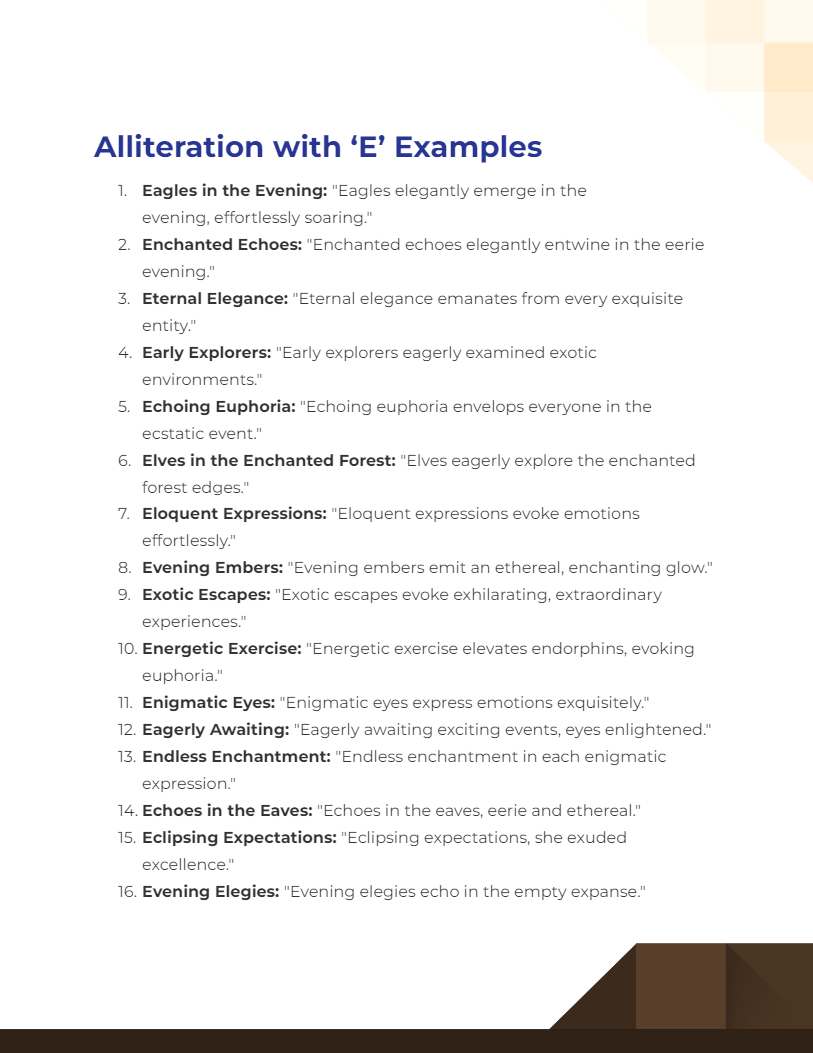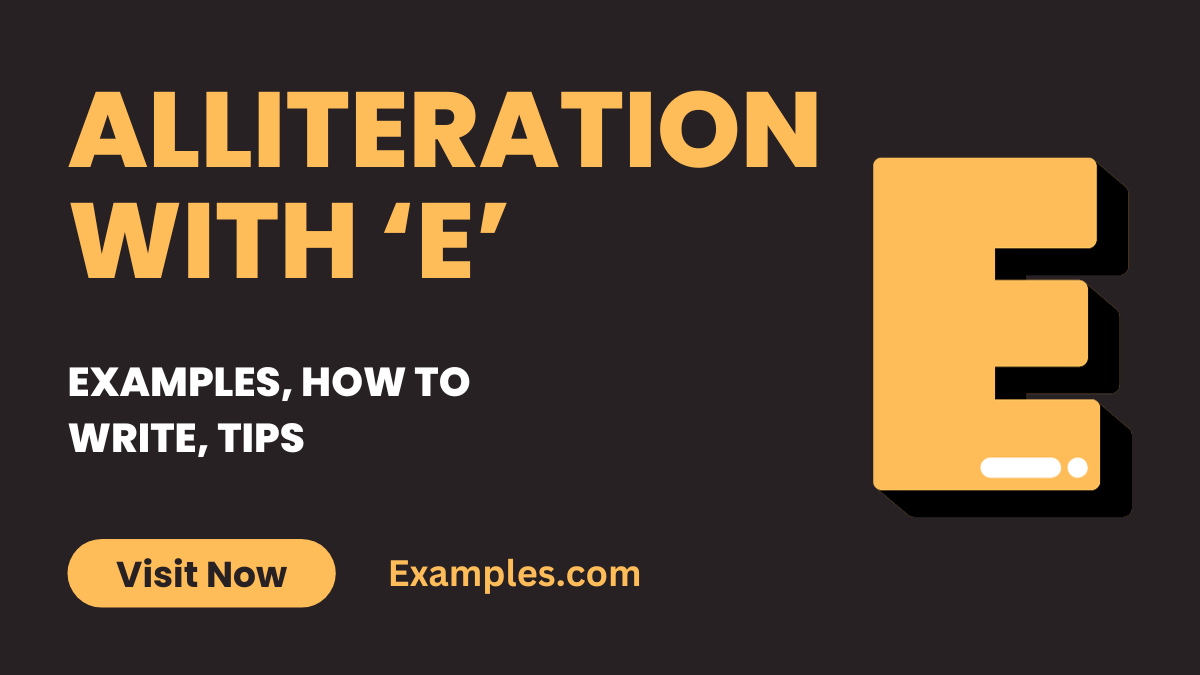15+ Alliteration with E Examples
Alliteration with ‘E’ brings a unique charm to the English language, turning ordinary sentences into rhythmic and engaging expressions. It involves the repetition of the ‘E’ sound at the beginning of closely connected words, creating a musical effect in both written and spoken language. This literary technique is often employed to emphasize certain points, evoke specific emotions, or simply to add a poetic flair to prose or poetry. Mastering alliteration and assonance with ‘E’ not only enhances writing skills but also enriches the reader’s experience, making the text more memorable and impactful. As a versatile tool, it finds its place in various forms of literature, from classic poetry to modern advertising, showcasing the enduring power of sound in language.
Download Alliteration with ‘E’ Examples
Download Alliteration with 'A' to 'Z' Examples
What is the Best Example of Alliteration with ‘E’?

Example: A classic example of alliteration with the letter ‘E’ is the phrase “Eager elephants eagerly eat enormous apples.”
Meaning: Alliteration is a literary technique in which consecutive words in a phrase or sentence begin with the same consonant sound. In the example provided, the consonant ‘E’ is repeated at the beginning of words like “eager,” “elephants,” “eagerly,” “eat,” and “enormous.” This repetition creates a pleasing rhythm and sound pattern in the sentence, making it more memorable and engaging. Easy Alliteration is often used in poetry, literature, and advertising to enhance the impact of words and phrases, making them stand out and resonate with the audience.
20 Alliteration with ‘E’ Examples

Download Alliteration with ‘E’ Examples in PDF
Alliteration with the letter ‘E’ brings an echo of elegance, excitement, and emotion to language. The ‘E’ sound, whether soft as in ‘echo’ or more pronounced as in ‘eagle’, adds a unique alliteration rhyme and energy to phrases and sentences. This versatile vowel can transform ordinary text into something more engaging and lyrical. Here are 20 unique examples of alliteration with ‘E’, each accompanied by a creative rhyme title to encapsulate the essence of the phrase.
- Eagles in the Evening “Eagles elegantly emerge in the evening, effortlessly soaring.”
- Enchanted Echoes “Enchanted echoes elegantly entwine in the eerie evening.”
- Eternal Elegance “Eternal elegance emanates from every exquisite entity.”
- Early Explorers “Early explorers eagerly examined exotic environments.”
- Echoing Euphoria “Echoing euphoria envelops everyone in the ecstatic event.”
- Elves in the Enchanted Forest “Elves eagerly explore the enchanted forest edges.”
- Eloquent Expressions “Eloquent expressions evoke emotions effortlessly.”
- Evening Embers “Evening embers emit an ethereal, enchanting glow.”
- Exotic Escapes “Exotic escapes evoke exhilarating, extraordinary experiences.”
- Energetic Exercise “Energetic exercise elevates endorphins, evoking euphoria.”
- Enigmatic Eyes “Enigmatic eyes express emotions exquisitely.”
- Eagerly Awaiting “Eagerly awaiting exciting events, eyes enlightened.”
- Endless Enchantment “Endless enchantment in each enigmatic expression.”
- Echoes in the Eaves “Echoes in the eaves, eerie and ethereal.”
- Eclipsing Expectations “Eclipsing expectations, she exuded excellence.”
- Evening Elegies “Evening elegies echo in the empty expanse.”
- Early Easter “Early Easter events, eggs elegantly exhibited.”
- Enthralling Experiences “Enthralling experiences in every expedition.”
- Elves and Enigmas “Elves encounter enigmas in the enchanted lands.”
- Exquisite Elegance “Exquisite elegance in every embroidered ensemble.”
Alliteration Sentence Examples with ‘E’
Alliteration sentences with ‘E’ exude a certain elegance and energy, using the ‘E’ sound to enhance the lyrical quality of the text. This vowel-based alliteration can range from soft and subtle to vibrant and vivacious, depending on the chosen words. Here are three examples:
- “Eagerly, Emily embraced the early morning elegance.”
- “Echoing endlessly, eerie sounds enveloped the empty estate.”
- “Energetic eaglets eagerly eyed the expansive sky.”
Alliteration Examples with ‘E’ Words
Alliteration examples using ‘E’ words can create an engaging and enchanting effect, making phrases more memorable and rhythmical. Here are three examples:
- “Every evening, ethereal elves emerge from the elms.”
- “Elegant emeralds embellished the empress’s exquisite ensemble.”
- “Eddie’s exuberant energy exhilarates everyone he encounters.”
Alliteration Examples with ‘E’ Vowel
Alliteration examples using the ‘E’ vowel often showcase a smooth, engaging sound that can add a lyrical and often emotive quality to phrases. The ‘E’ vowel, whether used in hard alliteration its short or long form, provides a versatile tool for creating memorable and rhythmic language. Here are three unique examples:
- “Eerie echoes emanate from the empty estate every evening.”
- “Energetic Elizabeth enjoys eating emerald green edamame eagerly.”
- “Every evening, eagles extend their enormous wings elegantly.”
Alliteration Examples with ‘E’ Sound
The ‘E’ sound in alliteration adds a sense of eloquence and excitement to phrases and sentences. These examples show the versatility and impact of the ‘E’ sound in alliterative songs structure. Here are three examples:
- “Eloquent echoes enhance the enigmatic environment.”
- “Enthusiastic educators enlighten eager learners every day.”
- “Eternal evening stars emit ethereal, enchanting light.”
Alliteration Poems with ‘E’
Alliteration poems with ‘E’ use the repetitive ‘E’ sound to create a flowing and rhythmic experience, often adding a lyrical and emotional depth to the poetry. Here are three examples:
- “Early in the East, / Eagles exalt in the ether, / Effortlessly they glide, an elegant feat.”
- “Echoes in empty halls, / Evoke eerie tales of old, / Enshrouded in mystery, stories untold.”
- “Enchanted by the emerald sea, / Endless waves whisper to me, / Evoking tales of mystery and glee.”
How to Write Alliteration with ‘E’?
Writing alliteration answers with the letter ‘E’ involves using words that start with the ‘E’ sound in close proximity within sentences or phrases. This vowel-based alliteration can add a lyrical, rhythmic quality to writing. Here’s how to create effective alliteration with ‘E’:
- Familiarize with the ‘E’ Sound: Understand the sound of ‘E’, which can be short as in “elephant” or long as in “eagle”. Being aware of the different sounds helps in choosing the right words.
- Select a Theme: Choose a theme or concept for your sentence or piece. This helps in finding words that not only start with ‘E’ but are also relevant to your subject.
- List ‘E’ Words: Brainstorm a list of words starting with the ‘E’ sound. Use a dictionary or thesaurus for a wider range of vocabulary.
- Construct Your Sentence: Arrange the ‘E’ words to form a sentence or phrase. Focus on creating a natural flow and rhythm.
- Read Aloud for Rhythm and Flow: The effectiveness of alliteration is best judged by hearing it. Read your sentence aloud to ensure it sounds rhythmic and fluid.
- Revise for Clarity and Impact: Make sure your alliterative phrase is clear and enhances the overall message of your writing. Edit as necessary to maintain balance between style and substance.
- Incorporate into Your Writing: Seamlessly integrate your alliterative sentence into your larger text, whether it’s a poem, story, or an article.
Tips for Using Alliteration with ‘E’
Here are the Tips for Using Figurative Alliteration Language:
- Use Sparingly: Alliteration should add to your writing, not distract from it. Use it judiciously to enhance your work without overwhelming the reader.
- Maintain Meaning and Clarity: Your alliteration should not compromise the clarity or meaning of your sentence. The content should always be easily understandable.
- Vary Word Lengths: Mix short and long ‘E’ words to keep the rhythm interesting and prevent monotony.
- Consider the Mood: The ‘E’ sound can be soft or energetic. Choose words that match the mood and tone you want to convey in your writing.
- Test the Sound: Alliteration’s impact is largely auditory. Reading your work aloud helps you catch the rhythm and adjust where necessary.
- Avoid Forced Repetition: Ensure that the repetition of ‘E’ sounds natural and not forced. Forced alliteration can feel awkward and disrupt the flow of your writing.
- Play with Word Placement: While traditional alliteration involves consecutive words, placing ‘E’ words at strategic points in a sentence can also be effective.
By following these guidelines, you can use alliteration with ‘E’ to add a distinctive, rhythmic quality to your writing, making it more engaging and memorable for your audience.
What Tongue Twisters Start with ‘E’?
Tongue twisters are the great alliterations starting with ‘E’ are phrases designed to be difficult to articulate properly, often using repetitive ‘E’ sounds. These are fun, challenging, and a great way to improve diction and pronunciation. Here are a few examples:
- “Eight eager eagles eagerly eyed eight eggplants.”
- “Eddie edited it, and Edna emitted it.”
- “Eleven elves licked eleven little licorice lollipops.”
These tongue twisters can be used in speech therapy, as warm-up exercises for actors and public speakers, or simply for fun.
What are the Alliteration with ‘E’ for Kids?
Alliteration for kids involves using words starting with the ‘E’ sound in a fun, engaging manner. This can be educational and enjoyable, helping children improve their language skills. Examples suitable for children include:
- “Ellie the elephant enjoyed eating elderberries.”
- “Eddie the eager eagle explored every evening.”
- “Emily’s eight elves eagerly exchanged envelopes.”
Such phrases can be used in children’s literature, educational games, or as part of language lessons to help kids learn phonics and vocabulary in an entertaining way.
What is the Effect of ‘E’ Letter in Alliteration?
The effect of the ‘E’ letter in alliteration is varied, depending on whether the ‘E’ sound is short or long. The ‘E’ sound can add a light, energetic, and sometimes ethereal quality to the text. Famous Alliteration can enhance the rhythm and musicality of language, making it more engaging and memorable. It’s effective in poetry, prose, advertising, and children’s literature for its ability to draw attention and emphasize key points or themes.
What is the Alliteration ‘E’ Type of?
Alliteration with the letter ‘E’ is primarily a form of vowel used in alliteration literature. This type involves the repetition of the vowel sound ‘E’ at the beginning of adjacent or closely connected words. Unlike consonantal alliteration, vowel alliteration like that with ‘E’ can produce a softer, more melodious effect. It’s often used in poetry and prose for its lyrical quality but is also prevalent in phrases designed for easy recall, such as in branding or advertising slogans. The ‘E’ alliteration is versatile, suitable for various contexts and styles, from playful and whimsical to serious and contemplative.


